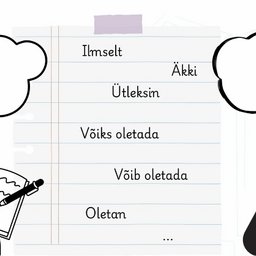Inimesed tahavad näida kindlad
. Kuid mõnikord on vaja öelda, et nad
ei tea täpselt
.
Inimesed tahavad näida kindlad
Tõlge fraasile: Inimesed tahavad näida kindlad
EN
People want to appear confident
ei tea täpselt
Tõlge fraasile: ei tea täpselt
EN
do not know exactly
Uurija õppib, kuidas öelda ebakindlust
. Ta kasutab sõnu nagu "võib-olla" või "äkki". Need sõnad näitavad, et kirjutaja ei ole kindel.
Uurija õppib, kuidas öelda ebakindlust
Tõlge fraasile: Uurija õppib, kuidas öelda ebakindlust
EN
The researcher learns how to express uncertainty
Näiteks
kirjas ülemusele
võib kirjutada "
äkki põhjus on selles
". See on parem kui vale kindlus.
kirjas ülemusele
Tõlge fraasile: kirjas ülemusele
EN
in a letter to the boss
äkki põhjus on selles
Tõlge fraasile: äkki põhjus on selles
EN
perhaps the reason is this
Miks see oluline on? Kirjutajad tahavad olla ausad. Nad tahavad öelda, kui nad
ei tea täpselt
. See aitab lugejaid.
ei tea täpselt
Tõlge fraasile: ei tea täpselt
EN
do not know exactly
Teadustöös peab tekst olema selge
. Kuid mõnikord on vaja öelda "
ma
ei tea täpselt
"
data-translations='{"en":"I do not know exactly","ru":"Я не знаю точно","uk":"Я не знаю точно"}'
data-article-title=""
data-article-id="827afe3d-a351-463c-bb02-eec59ef8f646"
aria-label="Save phrase"
title="Salvesta fraas">
-->
". See on aus.
Teadustöös peab tekst olema selge
Tõlge fraasile: Teadustöös peab tekst olema selge
EN
In scientific work, the text must be clear
ei tea täpselt
Tõlge fraasile: ei tea täpselt
EN
do not know exactly
ei tea täpselt
Tõlge fraasile: ei tea täpselt
EN
do not know exactly
ma
ei tea täpselt
ei tea täpselt
Tõlge fraasile: ei tea täpselt
EN
do not know exactly
Tõlge fraasile: ma
ei tea täpselt
ei tea täpselt
Tõlge fraasile: ei tea täpselt
EN
do not know exactly
EN
I do not know exactly
Noored kirjutajad kasutavad neid sõnu rohkem. Kogenud kirjutajad kasutavad neid vähem. Inglise keeles on teistmoodi.
Arvutid ei oska öelda "ma ei tea". See on probleem. Uurija tahab teada, kuidas inimesed mõistavad ebakindlust.
Kokkuvõte:
ole aus
. Ütle, kui sa
ei tea täpselt
.
ole aus
Tõlge fraasile: ole aus
EN
be honest
ei tea täpselt
Tõlge fraasile: ei tea täpselt
EN
do not know exactly
People want to appear confident. But sometimes it is necessary to say that they do not know exactly.
The researcher learns how to express uncertainty. They use words like "maybe" or "perhaps". These words show that the writer is not certain.
For example, in a letter to a supervisor, one might write "perhaps the reason is this". This is better than false certainty.
Why is this important? Writers want to be honest. They want to say when they do not know exactly. This helps readers.
In academic work, the text must be clear. But sometimes it is necessary to say "I do not know exactly". This is honest.
Young writers use these words more. Experienced writers use them less. In English, it is different.
Computers cannot say "I don't know". This is a problem. The researcher wants to know how people understand uncertainty.
Summary: be honest. Say when you do not know exactly.

